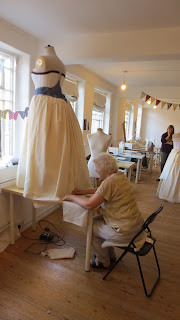We spent (are spending) this week on creating the toiles for our bustle gowns. A first step was creating the foundation skirt, for which we adapted the petticoat pattern. As they say in Dutch: by now that's a "makkie"! (simple). So no more about that.
For period gowns from the late 1870s or later 1880s, generally that foundation skirt at most peeks out from under voluminous draping, the (back) bustle, lace, ruffles, and potentially a train - these "drapings" are literally that, draped. A few pictures of my fellow students hard at work:
 |
| Jess (fore) and Emily (back) - Jess is working on the front "apron" |
 |
| Sofia - bustle on, now adding ruffles |
 |
| Alice working on the bustle |
 |
| Kas with yards and yards and yards... |
Me - I decided to forego bustle, drapings, ruffles, I just couldn't see myself in them. Instead, I became inspired by Emile Pingat (see some of his fabulous designs at An almost-forgotten Parisian designer) and Pauline allowed me to adapt an 1892 gown to the 1880s bustle craze. My concept: "Her Ladyship," simple but imperiously sweeping lines, a dramatic waist and trimmed train.
First step: try things out, and make things easier for yourself by elevating the mannequin!
Second step: stand back and evaluate. Verdict: concept good. However, with the trim, the train needed tweaking - take out the centre back pleat and add a (dramatic) godet to get the right profile. Rip seams, measure and cut godet, install. Done. Also, the trim was too wide and it should be edged closer to the hem. Noted in my "Draping Notes."
Just FYI, those are not the colours of the gown, blue just happened to be lying about in approximately the right shape. Will post about draping the bodice - when things get really challenging - in the next posting.


No comments:
Post a Comment